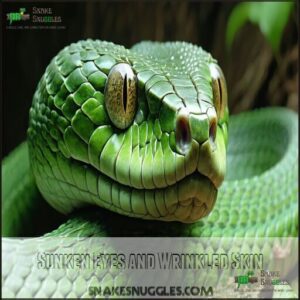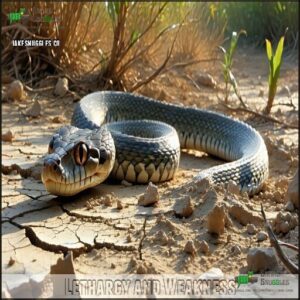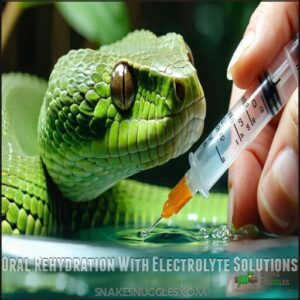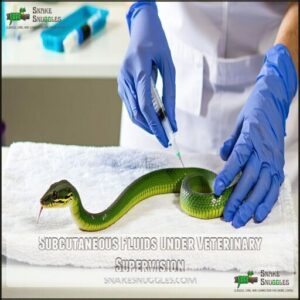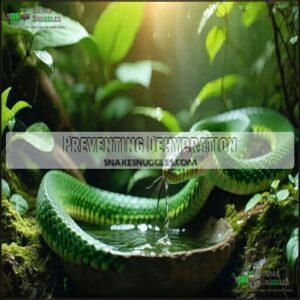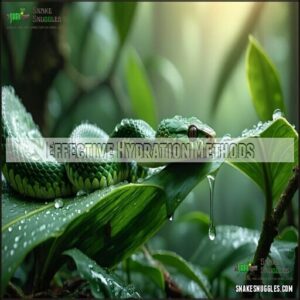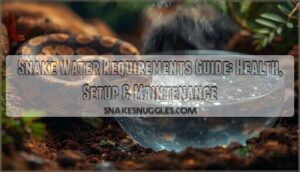This site is supported by our readers. We may earn a commission, at no cost to you, if you purchase through links.
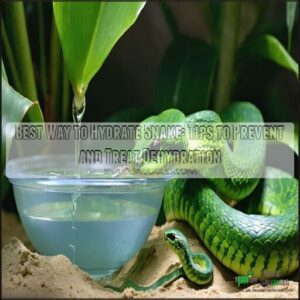
Misting your snake’s enclosure helps maintain appropriate humidity levels (50-70% for most species).
For dehydrated snakes, try a 20-30 minute soak in lukewarm water reaching half their body height.
Monitor for wrinkled skin, sunken eyes, and difficult shedding – all signs of dehydration requiring immediate attention.
Remember, the best way to hydrate snakes varies by species; desert dwellers need different care than tropical species, which is why understanding your specific serpent’s natural habitat is essential.
Table Of Contents
- Key Takeaways
- Recognizing Dehydration Signs
- Rehydration Strategies
- Preventing Dehydration
- Hydration and Environmental Factors
- Effective Hydration Methods
- Frequently Asked Questions (FAQs)
- What Kind of Diet Should I Feed My Snake to Prevent Dehydration?
- What Are the Long Term Effects of Dehydration in Snakes?
- How Often Should I Check My Snake for Signs of Dehydration?
- What Temperature Should I Keep My Snake’s Enclosure to Prevent Dehydration?
- Is Dehydration in Snakes Preventable?
- How do I rehydrate my snake?
- How do I moisturize my snake?
- How to tell if your snake is hydrated?
- How do snakes get hydrated?
- How often should I mist different snake species?
- Conclusion
Key Takeaways
- You’ll need to tailor hydration methods to your snake’s natural habitat—tropical species require 60-80% humidity with daily misting, while desert dwellers need just 30-50% humidity with occasional misting.
- Keep a clean water bowl large enough for soaking but not drowning, changing it daily and placing it near a warm area to encourage use.
- Watch for dehydration signs like sunken eyes, wrinkled skin lacking elasticity, stuck shed, and lethargy—these require immediate attention through soaking in lukewarm water.
- Create humidity gradients in the enclosure using moisture-retentive substrates (like coconut husk or cypress mulch), humid hides with damp sphagnum moss, and proper ventilation to prevent mold while maintaining moisture levels and providing a suitable environment for your snake.
Recognizing Dehydration Signs
Spotting dehydration in your snake early can prevent serious health problems, so it’s important to look for key signs.
Watch for symptoms like sunken eyes, wrinkled skin, or sticky saliva, which signal your snake needs immediate attention.
Sunken Eyes and Wrinkled Skin
Sunken eyes, resembling small dents in the eye socket, indicate snake dehydration. Wrinkled skin lacking elasticity or turgor pressure is another telltale sign.
Sunken eyes and wrinkled skin are urgent warning flags—your snake’s desperate call for hydration before crisis strikes.
Test this by gently pinching; if it stays wrinkled, hydration is needed. Dull scales signal dehydration severity, too.
Regular eye socket assessments and skin elasticity tests help you spot issues early. Prioritize rehydration methods to restore snake hydration effectively.
Environmental factors, such as insufficient cage humidity, can also contribute to dehydration.
Lethargy and Weakness
When snakes become lethargic or weak, it’s often due to dehydration affecting their energy and movement.
Watch for sluggish behavior or difficulty in holding their body upright, as these reflect dehydration symptoms.
Assess severity by noting their activity and feeding habits, as these snake health issues may signal dietary impacts or require veterinary intervention.
Prompt rehydration methods restore balance effectively, and it is crucial to address the issue to prevent further health complications, which may be related to dehydration symptoms.
Sticky or Dry Saliva
If you notice sticky saliva or unusually dry mucous membranes during an oral examination, it’s likely your snake is showing dehydration signs.
Saliva viscosity often increases as dehydration severity worsens.
Monitoring snake hydration is essential for snake health, so if symptoms persist, consult a reptile veterinarian promptly for diagnosis and treatment, ensuring your pet gets proper care to recover.
Retained Shed or Difficulty Shedding
Retained shed, where old snake skin doesn’t fully come off, often points to dehydration.
Humidity impact is significant—too low, and stuck shed causes issues.
Make certain proper diet and hydration support snake shedding.
If trouble persists despite increasing humidity, soaking, or using a humidity hide, consider veterinary assistance.
Shedding frequency may vary, but hydration maintains healthy snake skin.
Rehydration Strategies
To help a dehydrated snake recover, you’ll need the right techniques that address both immediate and long-term hydration needs.
From increasing enclosure humidity to offering electrolyte solutions, each method plays a vital role in restoring your snake’s health.
Increasing Humidity Through Misting
When addressing dehydration, increasing humidity through snake misting is key.
Mist the enclosure 1-2 times daily, adjusting frequency based on the snake species. Use high-quality water and select fine nozzle types for even coverage.
Pay attention to misting duration, ensuring the habitat materials don’t become oversaturated.
Consistent reptile misting boosts humidity control, supporting effective snake hydration.
Providing Humid Hides and Water Bowls
To boost snake hydration, a humid hide is a game-changer.
Use materials like damp sphagnum moss or paper towels in an enclosed space. Pair this with a properly sized snake water bowl placed near a warm spot to encourage use.
Many keepers purchase a pre-made reptile hide for convenience.
Clean the reptile water bowl daily to avoid bacteria and monitor snake behavior for hydration improvements. Ensure a properly sized snake water bowl is used to maximize effectiveness.
Oral Rehydration With Electrolyte Solutions
Switching from humid hides, oral rehydration with electrolytes is another effective method.
Use solutions like Pedialyte, diluted to 10-15%, for safer absorption.
Try these steps:
- Offer small drops via syringe or dropper.
- Opt for a 75% sports drink and 25% water ratio in baths.
- Avoid sugary solutions.
- Confirm the temperature matches their needs.
- Consult a vet for guidance.
Subcutaneous Fluids Under Veterinary Supervision
When oral rehydration isn’t enough, subcutaneous fluids can save the day.
Under veterinary supervision, fluid therapy involves injecting fluids beneath the snake’s skin at specific injection sites. Your veterinarian calculates the dosage to match your snake’s hydration needs.
This method provides targeted rehydration, and monitoring hydration levels confirms proper results.
Always rely on veterinary expertise for safe, effective care. Regular check-ups can help with early warning signs.
Preventing Dehydration
Preventing dehydration in your snake starts with keeping its environment properly humid and providing clean, fresh water daily.
Regular health checks and a balanced diet also play an important role in maintaining hydration and overall health.
Maintaining Proper Humidity Levels
Keeping the right humidity in your snake’s enclosure helps avoid dehydration.
Use a hygrometer for accuracy, ensuring levels fit your snake’s needs.
Balance ventilation to prevent mold while maintaining moisture.
Choose substrates like coconut husk for hydration. Mist regularly but avoid overdoing it.
Humidifiers can boost humidity when needed, making snake hydration and humidity-level management easier.
Providing Fresh and Clean Water
Your snake’s drinking bowl should always have fresh water. Choose a shallow bowl, large enough for soaking but safe from tipping.
Clean it daily to prevent bacteria. Use dechlorinated water for hydration; tap water sitting 24 hours works well.
Place the water bowl near the enclosure’s warmth to encourage drinking. Avoid water additives—they can harm snake hydration.
Regular Health Checks and Balanced Diet
A healthy snake means better hydration, so regular check-ups are essential for snake care. Monitor weight, skin elasticity, and shedding patterns to catch issues early.
A balanced diet prevents dehydration and boosts overall health. Keep an eye on appetite and fecal examination for clues about hydration status.
Proper snake enclosures are indispensable for their well-being.
- Check weight weekly.
- Test skin elasticity gently.
- Observe shedding consistency.
- Watch appetite for changes.
- Examine fecal quality to ensure overall health and detect any issues related to hydration status and proper snake enclosures.
Ensuring Proper Enclosure Ventilation
After maintaining a balanced diet, don’t forget the airflow importance in your snake’s home.
Proper enclosure ventilation prevents mold while maintaining humidity. Install screen tops or ventilation holes based on your species needs.
Remember, larger enclosures need more ventilation points. To guarantee proper airflow, consider ventilation product options.
Monitor humidity levels with a hygrometer to balance airflow with moisture. Different snake species require varying environmental conditions, so adjust ventilation types accordingly.
Hydration and Environmental Factors
You’ll need to customize your snake’s environment based on its native habitat, as proper humidity and temperature directly impact hydration needs.
Different species require specific conditions, from the high humidity needs of tropical pythons to the drier settings preferred by desert species like corn snakes, which is crucial for their overall well-being and hydration needs.
Species-Specific Humidity and Temperature Requirements
Proper prevention starts with understanding what your specific snake species needs. Different snake species have vastly different humidity requirements for ideal hydration.
Tropical snake needs differ dramatically from desert snake needs, affecting how you’ll set up their environment.
Here are five critical humidity requirements for different snake species:
- Amazon Tree Boas require 80-90% humidity
- Emerald Tree Boas need 80-90% humidity levels
- Milk Snakes prefer 40-60% humidity
- Corn Snakes thrive in 40-60% humidity
- Burmese Pythons require 50-70% humidity
Tailoring Hydration Strategies to Species
With the humidity requirements established for your snake’s species, you’ll now need to implement specific hydration strategies. Each snake has individual needs based on its natural habitat and evolutionary adaptations.
| Species Type | Hydration Strategy | Frequency |
|---|---|---|
| Arboreal | Frequent misting | 2-3 times daily |
| Desert | Shallow water dish | Always available |
| Temperate | Occasional soaking | Weekly |
Your snake enclosure setup should mimic these natural conditions while allowing you to monitor your pet’s water requirements easily, ensuring you provide the best environment for your pet’s species with the right hydration strategy in place.
Tropical and Desert Snake Hydration Needs
Different snake species have evolved unique hydration strategies based on their native habitats.
Tropical snakes require high humidity (60-80%) with daily misting and water droplets on foliage for drinking. They’re more susceptible to dehydration than their desert counterparts.
Tropical snakes thrive with 60-80% humidity, daily misting, and fresh water droplets—key to preventing dehydration and ensuring their health.
Desert snakes, meanwhile, obtain much hydration from prey and need lower humidity levels (30-50%). For both, substrate choice affects moisture retention—cypress mulch works well for tropical species, while aspen bedding suits desert dwellers.
Even snakes in marine environments, such as the yellow-bellied sea snake, require access to fresh water to avoid dehydration.
Boas and Pythons Hydration Requirements
Unlike their desert cousins, boas and pythons need more substantial water sources.
Your boa constrictor or python requires a stable water bowl large enough for full immersion.
Maintain humidity between 50-70%, adjusting specifically for ball pythons (50-60%) and boas (60%).
Soaking frequency of 1-2 times weekly for 15-20 minutes aids hydration and serves as a shedding aid.
Don’t forget a humidity box with damp sphagnum moss to complete their hydration needs.
Effective Hydration Methods
You’ll find several practical methods to keep your snake properly hydrated, from regular soaking sessions to creating ideal humidity conditions in their enclosure.
Implementing the right technique for your specific snake species guarantees they remain healthy and hydrated, preventing common issues like difficult shedding and lethargy.
Soaking and Misting Techniques
Now that you understand how different species have unique hydration needs, let’s examine practical soaking and misting techniques.
Soaking your snake for 15-30 minutes in lukewarm water (80-84°F) helps combat dehydration.
For tropical species, mist enclosures 2-3 times daily, while desert dwellers need only occasional misting. Don’t oversaturate substrates—they should be damp, not soggy.
Remember, proper reptile hydration techniques vary by species, so adjust your approach accordingly, and consider the importance of unique hydration needs.
Using Hygrometers and Humidifiers
While soaking directly hydrates your snake, proper humidity monitoring guarantees long-term health.
Place hygrometers centrally in the enclosure, away from heat sources for accurate humidity readings. Use multiple devices to verify measurements across different areas.
Digital hygrometers like REPTIZOO offer clear displays for easy humidity level monitoring.
When using humidifiers, clean them regularly and fill with distilled water to prevent harmful bacterial growth and mineral buildup.
Maintaining proper humidity helps with healthy scale shedding through practices like healthy scale shedding, which is crucial for your snake’s overall long-term health and ensuring they stay properly hydrated.
Creating Humidity Gradients and Microclimates
Inside your snake’s enclosure, creating humidity gradients and microclimates mimics their natural habitat and promotes ideal hydration.
Your reptile will thrive with these strategic setups:
- Position humidity hides at both warm and cool ends for microclimate options
- Layer substrates with varying moisture retention properties to create natural humidity gradients
- Integrate live plants to create localized high-humidity zones
- Establish temperature zones that affect humidity through ventilation effects
Always monitor these microclimates with a hygrometer to support your snake’s behavioral thermoregulation needs.
Choosing Moisture-Retentive Substrates and Decor
While creating proper humidity zones in your enclosure, the substrate choice becomes your next consideration.
Select moisture-retentive substrates like coconut husk bricks, cypress mulch, or sphagnum moss for ideal humidity retention. These materials should be layered at least 3 inches thick to support natural burrowing behavior.
Consider coconut coir options for enhanced substrate performance. Reptile bark offers both moisture control and natural aesthetics, while newspaper provides an economical, easy-to-replace option.
Remember to monitor with a hygrometer to prevent mold formation.
Frequently Asked Questions (FAQs)
What Kind of Diet Should I Feed My Snake to Prevent Dehydration?
Like a river sustains all life, your snake’s diet should include well-hydrated prey.
You’ll want to feed thawed, water-soaked rodents and avoid freeze-dried options.
Regular access to fresh water remains essential.
What Are the Long Term Effects of Dehydration in Snakes?
Chronic dehydration can damage your snake’s kidneys, suppress its immune system, and cause heart problems.
You’ll notice difficulty shedding, eating issues, and metabolic imbalances that may lead to organ failure if left untreated.
How Often Should I Check My Snake for Signs of Dehydration?
You should inspect your snake for dehydration signs weekly during routine care.
After handling, thoroughly check for sunken eyes, wrinkled skin, and lethargy.
During shedding periods, increase checks to every 2-3 days.
What Temperature Should I Keep My Snake’s Enclosure to Prevent Dehydration?
Maintain your snake’s enclosure temperature between 75-85°F (24-29°C) with a basking spot of 88-90°F (31-32°C).
You’ll need species-specific adjustments, as proper heat directly impacts hydration and overall health.
Is Dehydration in Snakes Preventable?
Yes, dehydration in snakes is completely preventable.
You’ll find that with proper humidity levels, fresh water daily, and regular health monitoring, you can keep your snake properly hydrated and healthy throughout its life, which is a complete concept that encompasses all aspects of snake care.
How do I rehydrate my snake?
Offer a shallow lukewarm bath (82-84°F) for 15-30 minutes.
Increase enclosure humidity to 60-70% by misting daily.
Provide a larger water bowl and create a humid hide with damp sphagnum moss.
How do I moisturize my snake?
Like parched earth craving rain, your snake needs proper moisturizing.
Mist the enclosure daily, provide a soaking dish, maintain 60-70% humidity, and use moisture-retaining substrates like coconut husk or sphagnum moss.
How to tell if your snake is hydrated?
Your well-hydrated snake will have bright, full eyes, elastic skin that springs back when gently pinched, smooth scales, proper shedding patterns, and active behavior.
It’ll also have moist mouth tissues and normal eating habits, which are key indicators of a snake’s overall health, with proper shedding patterns being particularly important.
How do snakes get hydrated?
Snakes drink water through their mouths, soak their bodies in water dishes, and absorb moisture from their environment.
You’ll need to provide a water bowl large enough for partial soaking and maintain proper humidity levels.
How often should I mist different snake species?
Tropical species need daily misting, while arboreal snakes require 2-3 times daily.
You’ll only need to mist desert species weekly or during shedding.
Always monitor humidity levels with a hygrometer for proper moisture balance.
Conclusion
Research shows the best way to hydrate snake species varies substantially based on their natural habitat.
You’ll need to balance water availability, humidity levels, and soaking opportunities to keep your serpent properly hydrated.
Monitoring for wrinkled skin, difficult shedding, and sunken eyes helps catch dehydration early.
Remember, what works for desert dwellers won’t suit tropical species.
By understanding your specific snake’s hydration needs, you’re ensuring not just their survival, but their ideal health and happiness, which is crucial for their overall well-being, and this understanding will help you provide the best possible care for your serpent.
- https://www.desertsun.com/story/life/home-garden/maureen-gilmer/2015/07/10/fantastic-snakes-find/29819691/
- https://www.researchgate.net/publication/242248692_CRITICAL_CARE_NUTRITION_AND_FLUID_THERAPY_IN_REPTILES
- https://europepmc.org/article/med/28778998
- https://www.vin.com/apputil/content/defaultadv1.aspx?id=5124283&pid=11343
- https://talis-us.com/blogs/news/keep-your-reptile-hydrated-with-premium-reptile-water-supplies?srsltid=AfmBOopsd-MyPYi8aRCwzwp9zttnA-e_9Ms8T_7gp-byph-QWW70rGqF

